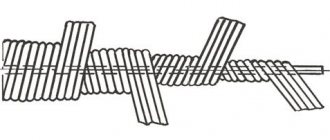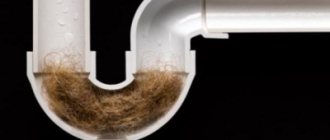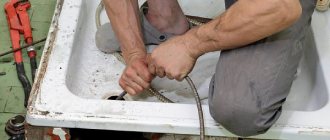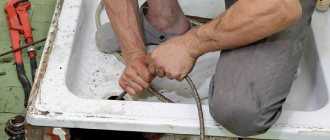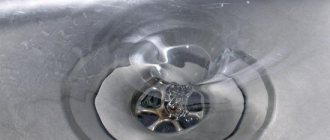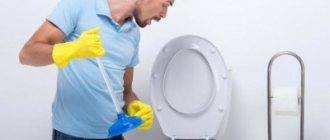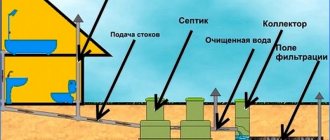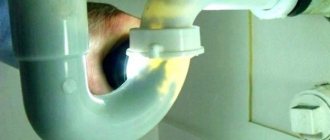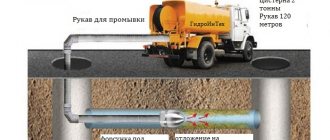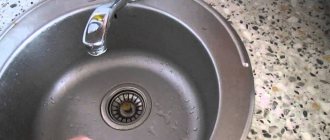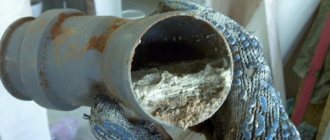In most cases, you can correct the situation on your own, using mechanical cleaning methods, special chemicals and even folk recipes.
In this article you will learn how to quickly and effectively clear a clogged kitchen sink at home.
Reasons for appearance
Before cleaning the drain, it is recommended to determine the cause of the blockage. The main ones include the following:
- Incorrect installation of plumbing. This could be, for example, installing waste pipes at the wrong angle.
- Foreign objects entering the drain that block and clog the pipe.
- Gradual accumulation of fat and other deposits in the pipes.
In cases where improper installation occurs, simply cleaning the pipes is not enough.
More complex method. Using an industrial vacuum cleaner
If none of the methods described above helped, you can try to correct the situation using an industrial vacuum cleaner.
We use an industrial vacuum cleaner
Step 1. Place a basin or bucket under the knee (hydraulic valve).
Place a bucket under the hydraulic seal
Remove the hydraulic valve
Step 2. Inspect everything carefully. There will be two pipes - horizontal and vertical (you will work with the latter, which is connected directly to the bottom of the sink).
Look straight ahead
Step 3. Place the tip of an industrial vacuum cleaner under the drain plug. Try to make the connection as tight as possible.
Place the tip of an industrial vacuum cleaner under the drain plug
Step 4. After this, you can turn on the vacuum cleaner.
Turn on the industrial vacuum cleaner
Step 5: Reach under the sink, holding the nozzle in place, to seal the bottom of the vertical pipe with your palm. This will increase the vacuum created by the device.
While holding the nozzle in place, reach under the sink to seal the bottom of the vertical pipe with the palm of your hand.
Step 6. Remove your palm to let in a small amount of air.
Remove your hand to let some air in
Step 7: Repeat the procedure several times to maintain suction power. This will increase the effectiveness of removing the blockage.
Repeat several times
Step 8: Remove what comes out from under the plug. This will take no more than a minute and may require some effort to remove all the dirt from the pipe.
Pull out the material that comes out from under the plug
Step 9: Reinstall the shutter. When installing, check the washers (if any) for damage. If you replace all damaged washers, you will prevent possible leaks in the future.
Reattach the shutter
How to clean mechanically?
Mechanical cleaning methods are often used to remove blockages . These include the use of a glass, a plunger or a special cable.
Plumbing cable
The cleaning cable is often metal. It has a handle on one side and a split, hard end for cleaning on the other.
Application:
- The working part is lowered into the drain.
- By turning the handle, the cable is moved along the drain pipe.
- After removing the cable from the drain, there may be debris at the end of the cable that is obstructing the passage of water.
- Repeat the procedure several times.
- Check the quality of cleaning by pouring water into the sink.
- If necessary, I repeat the processing.
Mechanical cleaning can be supplemented by using special chemicals or home recipes.
You can watch how to work with the cable in the following video:
Cup
For small blockages, when water passes through, but not as quickly as usual, even an ordinary glass can help.
Principle of operation:
- take some water into the sink;
- lower the glass so that it covers the drain hole;
- press and then sharply move your hand with the glass up;
- repeat several times.
Cleaning using this method is similar to the principle of using a plunger, but it will not help deal with serious blockages.
plunger
It is advisable to have a plunger in the household - a simple tool that will help deal with fresh blockages.
Procedure:
- fill the sink with some water;
- install the plunger so that the drain is completely covered with the working nozzle;
- press the plunger with force and pull it sharply towards you;
- repeat the treatment several times in a row, even if the plug has already been removed.
In addition to the usual plunger, you can use pneumatic models.
5 radical ways to ELIMINATE CLOGGES in a sewer pipe
When folk remedies do not help, you can resort to a mechanical method of removing clogs in drain pipes. There are several options for mechanical action on the accumulation of dirt and grease in the sewer. Let's look at the 5 most popular methods.
No. 1. By cable
Cleaning pipes using a cable
How to break through a blockage in a pipe? For punching you will need a special plumbing cable. It is used in cases where the plug has accumulated far from the drain hole. It is also good for removing blockages from bendy parts of pipes. Using a cable, it is easy to remove the accumulation of fat and debris or break the plug and free the pipe from contaminants.
How to break through a blockage with a cable - instructions:
- Removing the siphon. It is impossible to remove dirt from the pipes with a cable without first removing the siphon. Only after its dismantling will it be convenient to get to the sewer.
- Cleaning with a cable. Place the cable in the pipe and move it clockwise and move it forward. Movements should be smooth, not abrupt. If there is resistance along the path of the cable, you need to twist the cable until it passes the obstacle and moves on.
- Flushing the drain. After the plug is destroyed, you need to remove the cable, then replace the siphon, turn on the water and flush the drain.
Video instructions for removing blockages with a cable:
A special cable is sold in plumbing stores. But you can make the device yourself from an ordinary metal cable.
The master class on how to make it is quite simple:
- You will need a regular flexible, not very thick cable.
- One end must be bent and fluffed.
- A ring is attached to the opposite end of the cable. With its help it will be easy to scroll the cable.
- A small piece of plastic pipe is placed in the middle of the cable. This will be a kind of handle that will be convenient to hold the device while working. If there is no plastic pipe, the cable can simply be wrapped in any rigid material and secured.
This simple device is multifunctional. It can be used for a variety of jobs: cleaning drain pipes, water supply elements, heating, and even cleaning chimneys.
No. 2. Cleaning with a vacuum cleaner
Clearing a clogged pipe with a vacuum cleaner
A regular vacuum cleaner will help solve the problem. The only condition is that the device must be equipped with a blowing function. The end of the hose is wrapped in fabric with a not too tight weave. The material must be firmly attached with tape, thread or tape. The hose rests tightly against the drain hole at an angle of 90°C. The device turns on at maximum power. The air pressure will push out the resulting plug. This method will only be effective if the contamination has accumulated no further than 1 m from the drain hole.
No. 3. Using a plunger
Clearing a clog using a plunger
A plunger is a special device for clearing water drainage in sinks. The appearance of this plumbing tool is familiar to many. It is a rubber cup-shaped attachment mounted on a wooden handle.
A plunger is most effective when a blockage in a pipe in the house has formed close to the drain hole. The further away the plug is, the less effective the plumbing tool is. Plungers can be pneumatic or mechanical. The nozzle can be made in the form of a washer or a cone.
Removing blockages in sewer pipes with a plunger:
- Dry the sink from water. But it is necessary to leave a small amount of moisture directly around the drain hole.
- Plug other drain holes. If there are other sinks or bathtubs in the house, then it is necessary to close their drain holes with a stopper. This creates good pressure in the pipe.
- Install a plunger. The rubber bowl of the plunger should completely cover the drain hole.
- Pump the plunger. After installing the plunger, you need to make about 10 vigorous movements up and down. In this case, the bowl of the plunger must not be torn off the surface of the sink. Then quickly remove the plunger. Water with particles of the destroyed mud plug will begin to flow into the drain hole. When water fills the drain hole, you must quickly repeat the procedure, preventing the liquid from going down again.
Video instructions for clearing a clog with a plunger:
A sign that everything has been done correctly will be the complete drainage of water into the hole, along with the dirt. If this does not happen, then the procedure should be repeated several times. Perhaps the reason is that there are too many clusters and they could not be destroyed at once. If after the work done the water has completely gone down, then the cleaned pipes are washed with tap water. For preventive purposes, you can use a ready-made pipe cleaner. We will talk about them below.
No. 4. Dismantling and cleaning the siphon
Dismantling and cleaning the siphon
A clogged siphon is the most common reason for “obstruction” of water from the sink. To fix the problem, you need to disassemble the siphon and free it from contaminants. This is done as follows:
- Place a piece of fabric under the siphon. The material must absorb water well.
- Place a basin under the sink. Water will flow into it.
- Unscrew the solution nut that secures the siphon tube.
- Remove the siphon and clean it of dirt. This can be done with a brush or dish brush.
- Rinse the siphon under running water.
- Pour a mixture of vinegar and soda into the pipe that is connected to the sewer. A reaction will take place that will corrode the contaminants on the pipe walls. To consolidate the result, pour another 150 ml of vinegar into the pipe. Do the same manipulations several more times.
- After 15-20 minutes, pour 2-3 liters of hot water into the pipe. After this you need to wait 5 minutes.
- Place the siphon in its original position. Tighten the lock nut.
Disassembling and cleaning the siphon from blockages with your own hands:
If you follow these instructions, you can deal with the accumulation of dirt and grease in the pipes in just one time.
No. 5. Hydrodynamic method
hydrodynamic method of cleaning sewer pipes
Clearing blockages in pipes using the hydrodynamic method is used when none of the above methods have proven effective. But to carry it out, plumbers with special equipment are hired. The essence of this method is to use water that is supplied under high pressure.
This is done using a special machine. It supplies water under high pressure. A hose with nozzles of different sizes is connected to the device. The work takes place in 2 stages:
- At the first stage, the plug is broken through and preliminary cleaning of contaminants is carried out. For this purpose, a hose with large nozzles, called punching nozzles, is used.
- The second stage involves more thorough cleaning. In this case, smaller nozzles with a brush-shaped nozzle are installed at the end of the hose.
This method is effective for removing large, heavily compacted layers of grease and dirt from pipes.
How to remove using folk remedies?
Even simple homemade recipes can help solve the clog problem. But it is better to use them in cases where the blockage is not severe. If the water does not drain from the sink at all, it must be scooped out before cleaning.
Boiling water
This is the simplest and most accessible.
Procedure:
- It is necessary to bring at least 1.5 liters of water to a boil.
- Pour boiling water into the sink, being careful to direct the stream into the drain.
- If the water begins to go away, then after 1.5 hours the procedure must be repeated. Otherwise, you will have to try another drain cleaning option.
This method is suitable for flushing out the blockage only if the pipes are not made of plastic. Otherwise, only water with a temperature of up to 70 degrees can be poured into the sewer. Failure to comply with this requirement may result in damage to the plastic pipeline.
Vinegar and soda against fat deposits
To clear clogs caused by food debris, especially greasy food, the baking soda and vinegar method can be used.
Procedure:
remove all water from the sink;- pour ½ pack of soda into the drain hole;
- pour in ½ cup vinegar;
- plug the drain hole to ensure that the chemical reaction takes place in the pipes and not on the surface of the sink;
- wait until the chemical reaction with the formation of foam is completed;
- pour 1.5 liters of boiling water (hot water) into the sink drain hole;
- Run cold water for 3 minutes to flush out the drain.
You can use cleaning with soda and vinegar as a preventive measure.
Hangover pills
If the blockage is not severe and you don’t have soda on hand, you can use effervescent hangover tablets. Alka-Seltzer will do.
Application is simple:
- In a saucepan, mix 2-3 tablets of the drug with a glass of vinegar.
- Quickly pour the foaming solution into the drain.
- Immediately plug the hole with a rag.
- After 10 minutes, turn on the water under pressure.
Alternative use of tablets:
- Grind and pour 2 tablets into the drain.
- Pour in a glass of vinegar.
- Plug the drain hole in the sink.
- Wait a few minutes for the reaction to pass.
- Run hot water.
Salt and soda
Kitchen drain pipes are susceptible to deposits from grease that gets into the pipes when washing dishes.
Application procedure:
- combine 4 tablespoons of salt with 2 tablespoons of soda in a container;
- pour two glasses of water;
- pour into the drain;
- plug the kitchen sink drain;
- stand for 10 minutes;
- run hot water.
This method cannot deal with old blockages.
Causes of sewer blockage
Usually the sewer gets clogged at the most inopportune moment. More often this happens to residents of apartments with old communications. Especially when it comes to old cast iron pipes. This nuisance is associated both with the structural features of the sewer system itself and with the human factor. The first sign of a future problem will be slow drainage of water and, possibly, the appearance of an unpleasant odor from the drain hole. There are five main factors that contribute to pipe clogging:
- Fat blockages – account for 70-80% of all unpleasant cases. Washing machines, dishwashers, and kitchen sinks supply the largest amount of grease clogs into the sewer system. This case is relevant both for residents of high-rise buildings and for owners of private cottages.
Fat deposits gradually accumulate over many years before leading to serious consequences. The accumulation period depends on the quality of the pipe material and the correct installation. Fat deposits are heterogeneous in thickness. Their inner diameter is softer and has a jelly-like consistency, while the outer diameter, which is adjacent directly to the inner wall of the pipe, is very hard. This is explained by the fact that it is gradually reinforced with various fibers that fall into the drains. This could be small threads after washing clothes, hair, particles of undissolved powder and much more. Plus, these stable formations attract and absorb mineral salts from wastewater, which makes them even denser. If your sewer system is also leaky or designed in such a way that there is a draft that moves through the pipes, the fat layer will dry out and thicken even more. The presence of a draft is not the main reason for hardening. This can also occur due to a small amount of passing water. In other words, saving water does not lead to anything good , and the internal cavity of the pipes quickly becomes impassable. Whether your system is sealed or not is very easy to understand. In a negative case, a characteristic unpleasant odor will be present. Fatty blockages are the most persistent and the most difficult to remove. - Mechanical blockages account for only 10-20% of all cases. Mechanical blockages mean various objects that, in principle, should not fall into the sewer. For example, in the process of home renovation, where does the water with the remains of various mortars drain? Of course, into the toilet.
Personal hygiene items and items related to personal care. For example, cotton balls, adhesive bandages, ear sticks and even toilet paper are undesirable items for the sewer system. For all this, there is a trash can in the apartment. But what about the remnants of various solutions? You won’t take them outside and pour them straight into the sewer, right? In this case, it is necessary to thoroughly flush the system and make sure that the dirty water is gone without any residue. In a word - pour more water. Be sure to ensure that children do not throw small objects from toys or construction sets, as well as rags and puzzles into the toilet. For some reason they really love to do this. By the way, grounds from natural coffee, onion peels and peels of vegetables and fruits have a very detrimental effect on the condition of the pipes and contribute to the formation of blockages. This is especially true in the warm season, when there is an abundance of them. - Mechanical damage to the sewer system can occur due to foreign solid objects entering the system. In private homes, external sewer pipes can be damaged by tree roots. They can wrap around the pipe and simply crush it. A chip will form in this place, and its edges, according to the laws of physics, will protrude inward. This will serve as a barrier to the passage of water and will stop various debris, which will lead to the rapid formation of a traffic jam.
- Incorrect installation carried out by inexperienced specialists will definitely make itself felt after some time. A problem may arise if the pipes are located at too sharp an angle or, conversely, have a minimal slope, and also if the wrong, too small cross-section is chosen, or if the ends of the pipes were not cleaned at the junction or soldering points and burrs remained on them.
Such small omissions must be carefully monitored. The sewer drain may not work properly if drain pipes and valves are not installed. Blockages will become very common if the pipe turns are made at right angles, if the pipes are too bent in a small area and have many turns. - Exceeding the service life of the sewerage system. Even if the pipes in your system are installed correctly, but they are many years old, you are still at risk. Only their PVC pipes are practically not susceptible to the formation and retention of fatty deposits on the walls. If you are still using cast iron pipes, then you should know that their internal cavity is susceptible to corrosion, on the surface of which a coating of dirt and grease will happily linger.
By understanding the causes of blockages, in the future you will be able to protect yourself from unwanted consequences and operate your sewer system correctly.
How to quickly remove with special chemicals?
Various preparations can be used to clean kitchen drains. They are available in liquid form, in the form of granules in sachet.
The main point when choosing is to make sure that the product is suitable for the existing type of pipes and the expected type of contamination.
Bagi Schumanit
The drug, produced in Israel, is available in granular form . It allows you to completely eliminate the blockage in just 3 minutes, dissolving food residues and fat accumulations. Suitable for all types of pipes. Contains sodium hydroxide.
For the product to work, you need to remove the water from the sink. The contents of the sachet are poured into the drain and ½ cup of hot water is poured in. After 3 minutes, the sink is washed with a large stream of water.
Advantages:
- destruction of bacteria;
- elimination of odors;
- very high efficiency;
- fast action;
- dissolution of organic and inorganic substances.
Minuses:
- high price;
- caustic composition.
The average cost of a package is 150 rubles. The product is also available in gel form. Read reviews here, here and here.
Gel Mr.Muscle
The drug in gel form is an effective remedy that acts in a few minutes. If the plug situation is stubborn, the product may need more time to clear the drain.
Advantages:
- efficiency;
- ease of use;
- elimination of bacteria.
Minuses:
- caustic composition;
- price;
- high consumption of funds;
- for advanced cases it will take several hours.
Price – 300 rubles. You will find reviews here and here.
Tire Turbo
The gel is intended for cleaning pipes at home. The product is suitable for all types of pipes. Contains chlorine. A single treatment of one drain hole requires 250 ml of product.
Advantages:
- efficiency;
- works even when there is water in the sink;
- eliminates bacteria.
Minuses:
- price;
- high consumption.
Cost – up to 400 rubles. Reviews can be found here, here and here.
Heavy artillery: chemicals for blockages
If the previous methods did not help, and the problem arose again of how to remove a dense blockage in the pipe, then it is worth using heavy artillery against pollution, namely chemical agents. In this case, you can use only household chemicals or combine them with the above-mentioned folk remedies.
Blockages in pipes and their removal at home can be carried out using one of the types of household chemicals:
- liquid;
- alkaline;
- acidic;
- dry (powder).
This or that drug is chosen depending on what the pipeline is made of and the suspected type of contamination. In most cases, a universal acid-based product is chosen, which is suitable for cleaning both metal and plastic pipes. Acid easily and quickly corrodes plugs of any origin. In this case, you should strictly follow the instructions for use on the packaging.
Liquid clog removers are very convenient to use, but at the same time have a gentler effect on dirt.
What to do if your kitchen sink is very clogged - use aggressive chemicals along with traditional methods. For example, you first need to pour boiling water into the drain, let it sit for 15-20 minutes, then add a chemical solution and leave it for a couple of hours. After the allotted time has passed, the pipeline is thoroughly washed with running cold water. All contaminants from rust to grease will dissolve and go down the drain.
Important! Household chemicals are aggressive preparations, so they must be used with extreme caution, using protective gloves and a mask!
If this does not help, then the last measure you can take at home is to disassemble the siphon and clean it manually. If this does not help, then the blockage is deeper, it is beyond the reach of accessible blockage tools and is firmly lodged, here you can no longer do without the help of a specialist, and you should call a plumber.
Disassembling the siphon
Directly under the kitchen sink there is a siphon - a simple structure that can be disassembled. This method is very effective when the cause of the blockage is in the siphon. After all, the water draining from the sink first enters it.
Procedure:
- Free up space under the sink.
- Place a bucket under the siphon.
- You need to unscrew the plastic nuts holding the siphon. Or you can unscrew only the siphon sump nut. In this case, the entire contents of the sump will flow into the bucket.
- Clean and rinse the removed part.
- You can also disconnect the corrugated pipe leading to the drain and wash it as well.
- Install all elements in their original place.
If partial dismantling of the siphon is not possible, it is removed completely, disconnecting it from the sink and drain pipe, and then washed and cleaned in a separate container.
The procedure for cleaning the siphon can be seen in the video:
The sewage system is clean, but the water does not go away: causes and solutions to the problem
Stagnant water is not always a consequence of a clogged drain hole. Sometimes the reason lies:
- in a clogged siphon (often construction debris ends up there after repair work);
- in the incorrect bending of the corrugation that goes from the siphon to the sewer (if the siphon is a bottle type, then there must be a side outlet and an elongated lower part for the accumulation of water; if the siphon is a pipe siphon, then one of the pipes of the system must have a curved shape);
- plugs at the joints of silicone pipes, which were used to process these same joints.
You can solve the problem by eliminating the root cause:
- clean the siphon;
- check that the bend of the corrugation matches the type of siphon;
- remove the silicone plug (carefully clean it with sandpaper or the blunt side of a knife).
Features of cleaning plastic pipes
Cleaning plastic pipes requires special care. Despite the strength, the material from which the drainage system is made is susceptible to mechanical damage and exposure to very high temperatures.
The inner surface of the pipes is quite smooth; with proper installation, blockages in such a system occur less frequently than in cast iron drainage systems. This is explained by the fact that plastic is not prone to corrosion and the adhesion of various substances to the surface .
But during operation, food particles that fall into the kitchen drain can be deposited, causing a blockage. The best options for cleaning approaches are the use of a plunger, the use of home and special products.
Will non-specialized household chemicals help?
It’s definitely not worth using dishwashing detergents such as “Fairy” or “Myth” to clean pipes, as some of them contain surfactants, which also contribute to clogging of sewer pipes. Therefore, to remove blockages it is worth using specialized products that can be purchased at a regular household chemicals store.
Mr. Muscle
This product is inexpensive and copes well with problems. In addition to removing clogs, Mr. Muscle also disinfects the surface of the pipe. Using this tool is quite simple:
- Pour the contents of the bag into the pipe.
- Carefully pour 250 ml of powder. warm water.
- After half an hour, thoroughly rinse the sink or bathtub drain.
One package is enough for you to completely eliminate pipe problems.
Mole
A product from a domestic manufacturer, which costs no more than 80 rubles, can be very effective. Its only drawback: for the product to work, at least 2 hours must pass.
How to use "Mole":
- Pour in 200-250 ml. the contents of the bottle into the drain;
- Leave the product for 2 hours;
- After this, rinse the pipe thoroughly with powerful water pressure.
If necessary, use "Mole" again.
Pothan
The advantage of this product is that it can be used in any pipes, plastic and cast iron. In addition, the duration of action of “Pothan” does not exceed 5 minutes, which is quite convenient for those who do not have the desire or opportunity to wait a long time for the result. It's quite easy to use:
- Pour 100 ml into the pipe. products and 150 ml. boiling water;
- After 5 minutes, rinse the drain with hot water.
Floop
This remedy is quite effective even for severe blockages. It also removes hair stuck in the bathtub drain. But its effectiveness is offset by its causticity, so put on protective gloves, an apron and goggles before starting the procedure.
How to use:
- Pour in 300-400 ml. funds in the drain;
- Add 500 ml. hot water;
- After 5 minutes, rinse the drain thoroughly with cold water.
For different types of blockages, there may be a different dosage of water and “Floop”, so before use, carefully read the instructions written on the packaging of the product.
Call a plumber
In situations where you cannot cope with the blockage on your own, you will have to turn to the help of a plumber.
Also, the intervention of a specialist will be needed when the problem with blockage is related to the drainage system in the apartment or to the riser in the house.
The cost of the service is determined by the complexity of the problem and the necessary cleaning work. If replacement of units or individual parts is required, the customer pays for them separately. On average, in the capital, clearing a clogged sink will cost from 500 rubles.
Sewer system design
Wastewater collection systems generally consist of two large blocks - internal and external. If you live in an apartment building, your responsibility includes only that part of the sewer system that is located directly inside your apartment. Accordingly, troubleshooting the sewer system in the outdoor unit falls on the shoulders of management companies. But if you choose to live in a country house or in a country house, then your freedom will lead to the fact that you will have to maintain and, if necessary, repair the entire wastewater collection system - from the drain in the sink to the septic tank or collector.
Sewage scheme in the apartment
On a note! Let's look at the inside of the wastewater collection system in order to understand how it works, what malfunctions can occur in it, and how you can fix them yourself.
Prohibitions when cleaning
When starting to clear a clogged kitchen sink, you need to remember a number of prohibitions:
- Do not begin to break the plug while there are dishes in the sink. It and food must be removed in advance.
- You should not get to work without rubber gloves. This is especially important when using purchased chemicals, since such products have an aggressive composition.
- Do not use chemicals that are not intended for this purpose to clean pipes. They can emit toxic fumes and even damage pipes.
- You should not pour all the products that come to hand down the drain at the same time, as this can harm communications.
Composition of the indoor unit of the wastewater collection system
Water from the water supply usually ends up in sanitary fixtures. These include: sinks, sinks, bathtubs, toilets, shower trays and so on.
Plumbing fixtures
After use, waste water flows into the drain. A siphon is usually connected directly to the drain - a special curved structure that performs two functions: it preliminarily retains large objects that fall into the drain and creates a water plug (water seal), which prevents the spread of unpleasant odors from the sewer system directly into the home. The siphon is connected to an intermediate sewer pipe (usually pipelines with a cross-section of up to 5 centimeters are used for this), which in turn is connected to a sewer pipe that collects wastewater from several devices (usually with a pipe cross-section of up to 10 centimeters) and then goes into a sewer riser. or a drainage pipe carrying wastewater from a country house.
You might be interested in information about where the smell from the kitchen sink comes from and how to eliminate it?
Internal sewerage diagram
The most popular method of constructing gravity systems is “gravity flow”. In this case, wastewater from sanitary installations flows to the final collection or treatment site under the influence of gravity, without the use of any pumps. This design of the system also provides for a self-purification effect - new portions of wastewater wash away accumulated accumulations from the passage of previous portions. However, in some cases the self-cleaning system fails. This may occur under the influence of one of the factors.
- Oversized objects entering the wastewater collection system. This could be rags or pieces of fabric, scraps of plastic bags, large food waste, and so on. To prevent clogging of sewers with such items, shredders are often installed in kitchen sinks, which chop the incoming garbage into light, small fractions.
Often the sink gets clogged at the most inopportune moment.
- Also, a big problem for the sewer system is the hair and fur of pets, which, when they get into the drain, get caught on the slightest roughness and additionally retain debris suspended in the water.
- Clogging of drains with fatty substances. This is especially true for kitchen sinks and dishwashers. The fact is that animal fat used in cooking has different melting and solidifying temperatures. When washing dishes, grease goes down the drain with streams of hot water, but then, as the drains cool, it settles on the inner surface of the sewer pipelines. Over time, such accumulations can reach significant sizes and interfere with the passage of wastewater.
Clogged kitchen sink
Important! Any blockage that has formed in the sewer can be removed by you yourself. For this purpose, various techniques have been developed, which are conventionally divided into two main methods of removing blockages: chemical and mechanical.
Prevention measures
To prevent blockages from recurring, preventive measures should be taken into account:
- Periodically you need to rinse the sink by running boiling water or hot water if the pipes are made of plastic;
- It is necessary to insert a special strainer into the kitchen sink drain, which will prevent large fragments of food waste from getting into the drain;
- You should not shake bread crumbs into the sink, wash off tea leaves, or pour out greasy liquid, as all this will stick to the pipes and accumulate in the siphon.
Available means
The list of available means consists of those substances and tools that are either already available on the farm or can be easily purchased. For example, soda, vinegar and hot water are usually found in any home. And a plunger, even if you don’t have one, can be borrowed from your neighbors or purchased at any hardware store, since its cost is low.
The simplest option is to flush the pipe with hot water, which can dissolve fats. If we are talking about steel pipes, you can use boiling water. It is better to rinse the plastic pipeline with ordinary hot tap water by opening it for a few minutes. By also introducing a plunger into the procedure, you can achieve a fairly good effect: it is better to do this after the blockage has already been softened with hot water.
Tips from the professionals
Tips from plumbers will help you better cope with cleaning your kitchen sink:
If clogged pipes are a frequent and regular occurrence in your home, then it makes sense to purchase a plumbing cable. It is inexpensive and will last for many years. Having a comfortable handle at one end is a must.- If the problem with blockages is related to installation errors, it is recommended to correct them, otherwise blockages will occur constantly.
- If the blockage was broken through with a cable, it must then be cleaned of dirt and dried. Store in a dry place, rolled up.
- It is better to clean drains in the kitchen with the window open so that there is an influx of fresh air, since in most cases the smell will be unpleasant.
- The combination of mechanical and chemical methods makes pipe cleaning more effective. For example, use a plunger, and then use special household chemicals.
If you are interested in how to clear a clog in a pipe, sink or toilet, take a look at this section.
Sewage clogged areas
To effectively remove the blockage without resorting to the help of specialists, you need to navigate the problem areas. To do this, you need to understand the structure of the sewer system. Let's take a closer look:
- If clogged kitchen sink or washbasin. There is no need to panic, but the first thing you should do is look under the sink. There you will see a siphon, which has a sump in the form of a bowl, from which a pipe goes directly to the riser. In most cases, it is the siphon. Due to the peculiarities of its design, it performs several functions at once: it collects most of the garbage and heavy particles at the bottom of the bowl and prevents the penetration of unpleasant odors from the sewer into the apartment or house. The water that is constantly present in the sump traps these “aromas”. You will understand that the system requires cleaning when so much debris has accumulated in it that there is simply no room left for water, and odors begin to seep through. The first step is to unwind the siphon. You should start from its bottom. Be prepared to be greeted by stench and possibly dirty, dark water flowing. Sometimes the siphon is twisted very tightly. To avoid stripping the threads and damaging it, wrap it in cloth and try again. Be sure to place a basin or bucket under the siphon to prevent dirt from getting onto the floor. And don't forget to wear rubber gloves.
Remove debris from the sump . In the case of a kitchen sink, these will be large pieces of food, onion skins and other food particles. In the case of a bathroom sink , in 90% of cases it will be hair . They may be wrapped around the threaded part and may be difficult to remove. After the accumulations in the sump have been completely removed, it must be rinsed thoroughly with hot running water and only then screwed into place. Turn off the water and see if the water flows well. If there is a result, but it is not sufficient, you need to unscrew the siphon completely. Sometimes it happens that hair gets wrapped around a long screw, which acts as a fastening element. You should unscrew it from the top, and hold the siphon from below so that it does not scroll. - If The bathroom drain is clogged. The main reason for this type of blockage is the large amount of hair that gets into the system while washing your hair. You must perform the same steps as in the previous case. The first thing you need to check is the siphon.
- Less often, but it happens The toilet drain is clogged. This can happen if it is not used properly or if a foreign object gets into the system. We have already said that with frequent and regular flushing of building mortar residues into the toilet, clogging is inevitable.
The same thing will happen if you throw plastic bags, personal hygiene products and used baby diapers down the toilet. If water does not pass through during flushing, it is necessary to unscrew the wide flexible corrugation, which is located at the back of the toilet and is connected to the riser. And with your own hands remove from there a foreign object that interferes with the normal functioning of the system. Cement or plaster residue should also be removed whenever possible. Again, do not forget to place a basin under the corrugation. The drain may not work if the corrugation does not have a slope and is installed almost perpendicular to the drain. Pay attention to this point too. You can fix this problem yourself only by raising the level of the toilet and setting up an impromptu podium. After all, the corrugation is inserted into a ready-made hole in the riser, which is almost impossible to redo.
